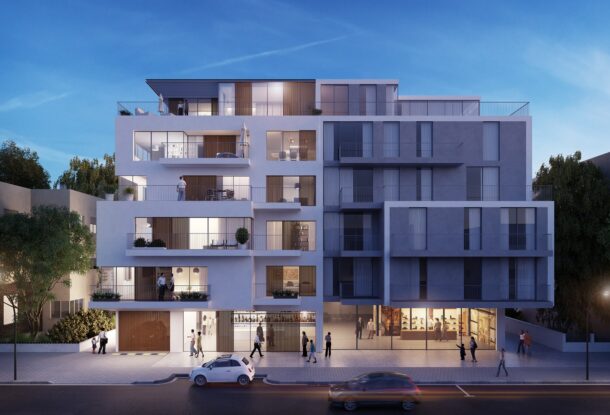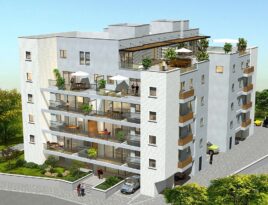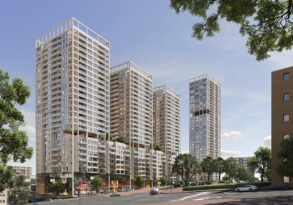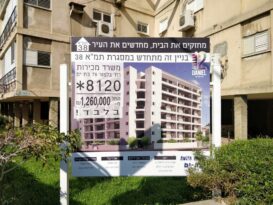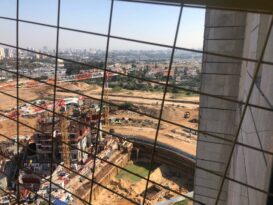The troubling combination of a shortage of building plots and a rapidly increasing population has led to a steady rise in the number of urban renewal projects in Israel over the past decade. Today, 20% of all new residential projects in Israel are either the demolition of old structures followed by new construction in its place, or the addition of new floors on top of existing buildings. However, the National Economic Council claims that this number is insufficient and that the scope of the projects must continue to rise rapidly – up to 45% of all new apartments in Israel and more than 70% of new apartments in the center of the country. Without such an increase, the Council warns of an upcoming “catastrophe”.
In 2017, the National Economic Council, a financial advisory body to the Israeli government, published the “Strategic Housing Plan.” This detailed document calculated how many apartments the State will need in order to house the entire population from 2017 to 2040, the annual construction rate required, and in which geographic areas new projects should be built. However, one of the figures that attracted public attention was the urgent statement regarding the need to immediately increase the amount of urban renewal projects in the country.
This is the first article in a series on urban renewal in Israel, a sector that is gaining momentum and is expected to become the most significant in Israel’s construction industry.
“Without a significant increase in urban renewal projects, we will face a catastrophe – the total depletion of available space designated for construction in the center of the country,” it read. This report gave the official sanction for what is already perceived as a fact among many in the Israeli construction industry – the future of residential construction in Israel is in urban renewal, and in hi-rise buildings in areas that have previously been occupied with only low construction, simply because Israel has no other choice.
Without a significant increase in urban renewal projects, we will face a catastrophe – the total depletion of available space designated for construction in the center of the country.
NATIONAL ECONOMIC COUNCIL, 2017
These statements were especially relevant for the Tel Aviv district, the most densely populated area in the country, which includes Tel Aviv and the neighboring cities of Ramat Gan, Holon, Bnei Brak, Givatayim, Bat Yam, and Herzliya. There is almost no available land left for residential construction in this entire region. In order to meet the construction targets of this area, the plan set ambitious goals: in 2020, 40% of all new residential apartments in the district will be part of urban renewal projects, rising to 60% in 2030, and 72% in 2040.
In the Central District, which includes the larger area encircling Tel Aviv – from Netanya in the north, to Yavneh in the south, and Modi’in in the east – the goal is for 55% of new residential apartments to be built as part of urban renewal projects by 2040. On a national level, the target is for 20% of all new apartments built throughout the country in 2020 to be part of urban renewal projects, rising to 35% in 2030 and 46% in 2040.

Why is there such a desperate need for urban renewal in Israel?
There are several different factors contributing to the urgent need for urban renewal projects in Israel – some of which are inevitable, and others which are the product of policy. For starters, Israel is a relatively small country, with an area of about 21,500 square kilometers (not including Judea and Samaria), with a population growth rate of close to 2% per year – the highest among the OECD countries.
On top of this, in recent years, the government has halted its efforts to encourage population distribution throughout all regions of the country. It has reduced investments in the periphery and stopped incentivizing young couples to build their future in the Negev and Galilee, where there is still a larger supply of available land. The vast majority of Israelis continue to live in the center of the country, characterized by better services, a higher standard of living, and more employment opportunities. However, the land available for development in this area is quickly running out.
20% of all new construction in Israel is currently through urban renewal
Over the past decade, there has been a significant rise in urban renewal in Israel. While such projects were extremely rare in 2010, today, the housing market boasts hundreds of projects of this kind in various stages of execution. Although it is not clear whether the Israeli construction industry will be able to meet the ambitious goals set by the Strategic Housing Plan, the construction data of recent years indicates a steadily increasing rate of urban renewal projects.
While in 2016, 6,800 apartments were built as part of urban renewal projects, that number jumped to 9,800 in 2017, and to 11,000 in both 2018 and 2019. According to data from the Central Bureau of Statistics in December, in the last four quarters (October 2019 to September 2020), of the 49,810 new apartments built in this period, 9,900 are urban renewal projects, comprising 20% of all new construction in the country.

Three different tracks in Israel
Urban renewal can be divided into three main categories:
- Tama 38/1 — the construction of new apartments built as an addition to an existing building, usually by adding upper floors and closing in the lower “column floor”, while simultaneously strengthening the foundations and restoring the original building. Tama 38/1 is a national construction plan that allows developers and apartment owners in buildings built before 1980 to begin a construction project for urban renewal without getting approval for a whole new building plan, rather by having a building permit issued by the local authority.
- Tama 38/2 — also relevant to buildings over 40 years old, involves the complete demolition of the old building and the construction of a new structure with a higher number of floors and apartment units in its place. Tama 38/2 is an update of Tama 38/1, which also does not require the approval of a new plan. While both types of Tama 38 plans are due to expire in October 2022, the government has already begun preparing a replacement plan of a similar nature.
- Pinui-Binui — also includes demolition and construction, but this time not only of an individual building. Known as “pinui binui” (literally, “evacuation-construction”), this procedure involves the demolition of an entire complex of buildings or sometimes a whole neighborhood and the construction of a new complex in its place. In contrast to Tama 38, pinui binui for urban renewal requires the approval of a new plan from the local or district planning committees.
The decision regarding which of the three urban renewal building schemes will be executed is usually made based on the municipality’s policy about where each type can be carried out, as well as the value of the land and the physical conditions of the particular plot.
Although the mechanisms for urban renewal exist, they do not operate in the same way for every city. Most are irrelevant to peripheral cities, where land values are low making the proceeds from the sale of new apartments too little to fund construction work. On the other hand, in central Israel, some local authorities fear that the flooding of urban renewal construction projects will threaten the existing infrastructure, such as roads and sewage systems.
